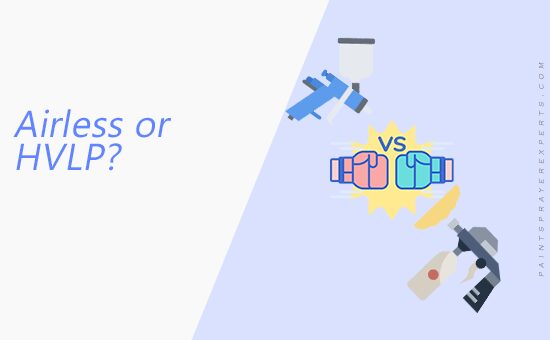Airless paint sprayers and High-Volume-Low-Pressure (HVLP) paint sprayers are two tools that are well-known for being both highly similar yet, at their core, profoundly different, at the same time.
Their greatest similarity arguably lies in the fact that they’re both classified rightly as sprayers, delivering paint materials through the same final method.
But at their base lies the mechanism behind this application, and this is where their differences are most profoundly felt.
Continue reading as we take you on a journey to establish further the mechanism, similarities, and differences between an airless paint sprayer and an HVLP.

Mechanism
Perhaps the simplest way to characterize the difference in mechanism between an airless paint sprayer and an HVLP is this: in an airless paint sprayer, the paint material is delivered through pressurization, while in a High Volume Low Pressure (HPLV) sprayer, the delivery is done with the help of a turbine/ compressor.
In an airless sprayer, a piston pressurizes the paint material, which then sprays out a small orifice (smaller than that found on an HVLP nozzle).
In an HVLP, the same atomization process is carried out, but this time it is done by the air pumped out by an air compressor or turbine.
Differences
1. Paint Consumption
One of the most prominent differences between airless paint sprayers and HVLPs is the paint consumption of either, which is also known as the “transfer rate”.
Thanks to the fact that the transfer rate of an HVLP is about 90% (meaning 90% of the material gets delivered while 10% may be subjected to waste), while that of an airless paint sprayer is 60%, an HVLP is generally more preferable in this regard than the airless sprayer, especially for those willing to conserve a low volume of paint for a large volume of paint job to be done.
2. Performance
Performance-wise, the line between both the airless paint sprayer and the HVLP is not so wide but is still discernible. The consensus on this is that when it comes to significantly improve paint quality, then the HVLP is superior. This is because the pressure is way more flexible than that found in its airless counterpart.
The hot compressed air of the HVLP also offers an advantage in the faster drying of paint materials applied through this method.
3. Finish Quality
Airless paint sprayers generally produce a higher finish quality than the HVLP sprayers, and thus professionals seeking that elevating amount of smoothness and gloss generally prefer the airless.
The reason for the airless sprayer’s amazing finish quality is its airless pressure system, which helps reduce the chance of air blending with paint, thereby offering bolder and smoother finish.
4. Work Volume
For working with a large number of materials ranging over a large distance, airless paint sprayers are the more appropriate option. They help you get a lot of work done in a short amount of time.
HVLP, on the other hand, are used for tasks requiring not so much time conservation, but a higher degree of accuracy and efficiency. They help you get a short amount of work done with as high accuracy as possible.
5. Speed
Regarding speed, airless paint sprayers are slightly ahead of their air counterparts in HPLV. The difference is significant, but not significant enough to cause a wide gap.
In fact, in terms of speed both are highly fast, and this could as well have been a similarity, but thanks to the edge the airless has, due to its pressure, we can’t help but name it a difference – albeit a slight one.
6. Cost
Air paint sprayers such as HVLP are always cheaper to acquire than the airless sprayers.
The price range for the latter is between $20 – $100, or in very rare cases, slightly higher, while airless sprayers are sold in the range of $200 – $1000 in some extreme cases.
The higher cost of the airless is due to its superiority in terms of ease and speed, and of course the smooth finish. Both can also be rented at significantly cheaper costs.
7. Safety
When it comes to safety, HVLP sprayers are generally regarded as safer than the airless paint sprayers.
Now it should be noted that both these devices come with their fair share of risks, and where the safety precautions in the manual are followed to the letter, the chances of accidents are greatly minimized.
The reason for the increased risk level of the airless paint sprayer is the high level of pressure at which it operates, which can easily break glasses, curve metals, and even pierce the skin.
Similarities
1. Maintenance
Both airless paint sprayers and HPLV require a significant amount of maintenance procedures to be carried out to religiously ensure both efficiency and longevity, and of course to prevent malfunctioning.
These procedures are highly similar, too, and they include practices such as pressure relief processes, cleaning of guns and hoses, and so on.
2. Ease-of-Use
Both devices boast of being, at the same time, very easy to use, but also requiring a curve to master. You have to first get familiar with the mechanism and safety precautions of both, maintenance practices, and then begin to learn how to prime and de-pressurize.
These may all seem like some complicated processes when in actuality they are not. And the best part is, once you’re used to them, you begin to master them and in no time, it all becomes as easy as it gets.
3. General
Other general similarities between both include the fact that they are both applied with a gun, both fast and efficient, and are much more advanced than brushes and rollers.
There are also numerous similarities even in properties which we regarded as being differences above, an example is the performance and finish quality.
While they both have a slight edge over each other in these cases, they both offer remarkable results in both metrics regardless and are way better than other options.
